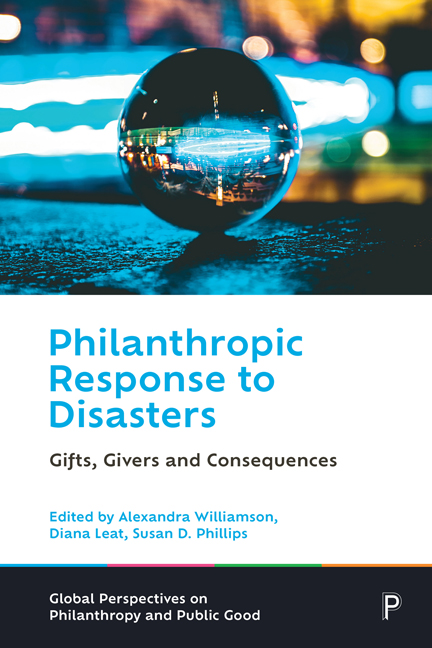Book contents
- Frontmatter
- Contents
- List of tables and figures
- Notes on contributors
- Series editors’ preface
- 1 Introduction
- 2 The public’s philanthropic response to disaster: plus ça change?
- 3 Disaster fundraising: readiness matters
- 4 Roles of philanthropic foundations as funders and distribution agents in disaster response
- 5 The private sector and disasters: from reactive response to disaster resilience
- 6 Fundraising, grantmaking and regulatory issues: regulating good in bad times
- 7 Doing good better: public policy for disaster philanthropy
- 8 Philanthropy’s place in community-based capacity development for disaster resilience
- 9 Nonprofit collaboration and coordination in disaster response: lessons from the 11 September recovery
- 10 The promise and reality of philanthropy in disasters
- 11 Conclusions and looking forward
- Index
2 - The public’s philanthropic response to disaster: plus ça change?
Published online by Cambridge University Press: 17 January 2024
- Frontmatter
- Contents
- List of tables and figures
- Notes on contributors
- Series editors’ preface
- 1 Introduction
- 2 The public’s philanthropic response to disaster: plus ça change?
- 3 Disaster fundraising: readiness matters
- 4 Roles of philanthropic foundations as funders and distribution agents in disaster response
- 5 The private sector and disasters: from reactive response to disaster resilience
- 6 Fundraising, grantmaking and regulatory issues: regulating good in bad times
- 7 Doing good better: public policy for disaster philanthropy
- 8 Philanthropy’s place in community-based capacity development for disaster resilience
- 9 Nonprofit collaboration and coordination in disaster response: lessons from the 11 September recovery
- 10 The promise and reality of philanthropy in disasters
- 11 Conclusions and looking forward
- Index
Summary
Ralph Ellison once said that Americans have two versions of history, ‘one which is written and as neatly stylized as ancient myth, and the other unwritten and as chaotic and full of contradictions, changes of pace and surprises as life itself.’
Jones, 2013, p xviiIntroduction
This chapter looks at the history of philanthropic responses to disasters. It is not a chronology of such responses. You would need a tome and a long working life to produce a timeline covering everything from the eruption of Vesuvius to the Great Plague to the Lisbon earthquake to famines throughout the world in the 18th and 19th centuries, to iconic moments of the 20th century such as Live Aid and the response to the 2005 tsunami, and on to the 2020 bushfires, COVID-19 and the humanitarian crisis caused by Russia's war on Ukraine.
The focus of the chapter is on the public response, rather than on that of philanthropic foundations. Most of the work on philanthropic responses to disaster is concerned with the act of giving – as indeed is the wider discussion of philanthropy (see, for example, Kapucu, 2016). This chapter instead looks at the larger philanthropic response narrative: the things on people's minds (Schiller, 2019) including giving and, crucially, when and how the donated money is distributed. Ralph Ellison once observed that there are two versions of history: one is written and stylised as myth, the other unwritten, chaotic and full of contradictions (1995, quoted in Jones, 2013, p xvi). This chapter aims to correct some of the myth and reveal the chaos and contradictions in the history of philanthropic responses to disaster.
The analysis draws primarily on examples from the 19th and 20th centuries thus covering both before and after widespread use of radio and television, popular foreign travel, use of the internet and social media and, in many countries, widespread state welfare provision and insurance. These innovations all had implications for the ways in which disasters were communicated, understood and addressed.
The examples cover ‘natural’ and man-made disasters including fires, floods, earthquakes, famine, a train crash, the collapse of a stadium, the sinking of a boat, a war, and terrorism. The data are not ‘representative’ – whatever that might mean in this context given there are so many variables including type of disaster, culture, economy, welfare regime, religion and charity regulation.
- Type
- Chapter
- Information
- Philanthropic Response to DisastersGifts, Givers and Consequences, pp. 26 - 43Publisher: Bristol University PressPrint publication year: 2023



